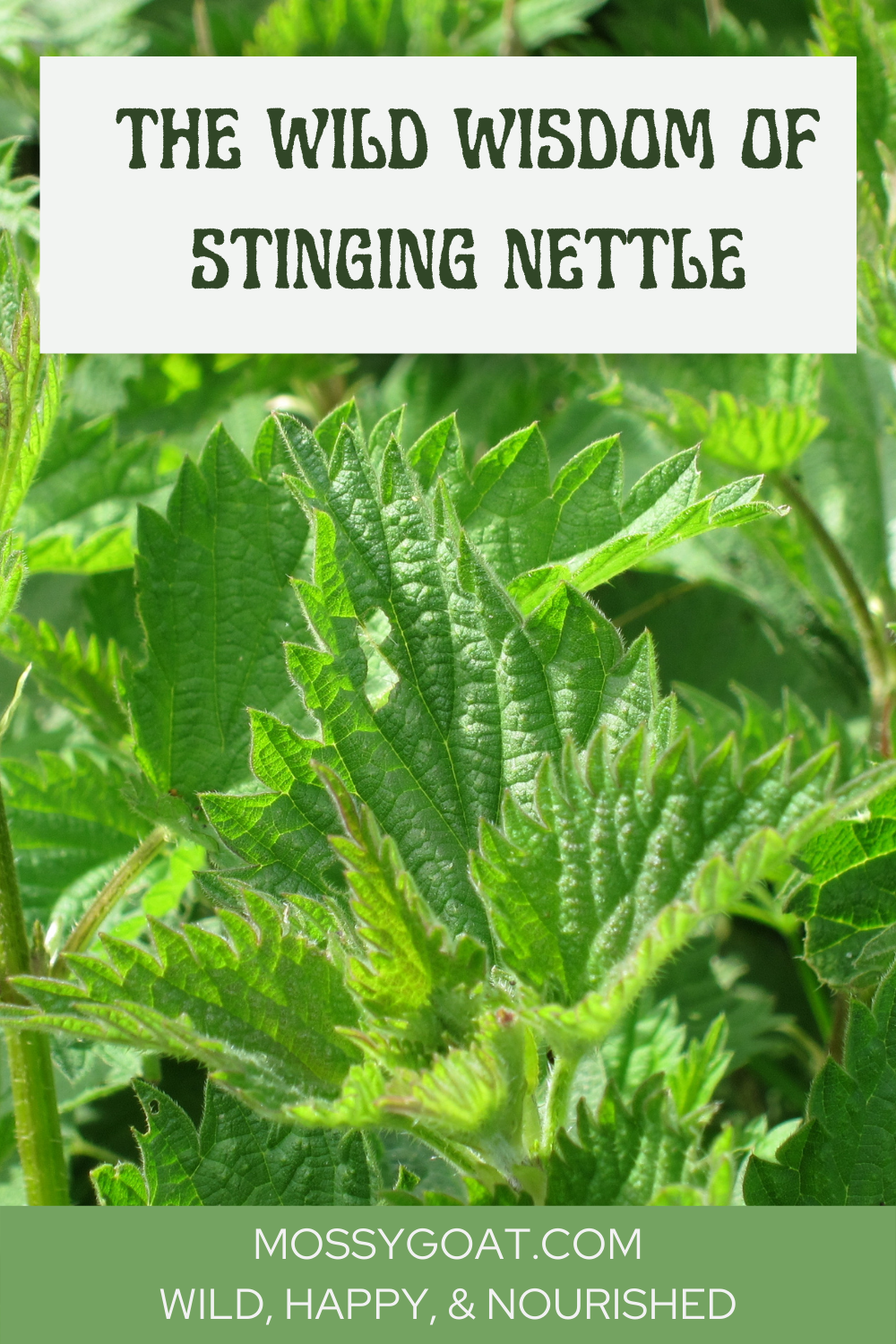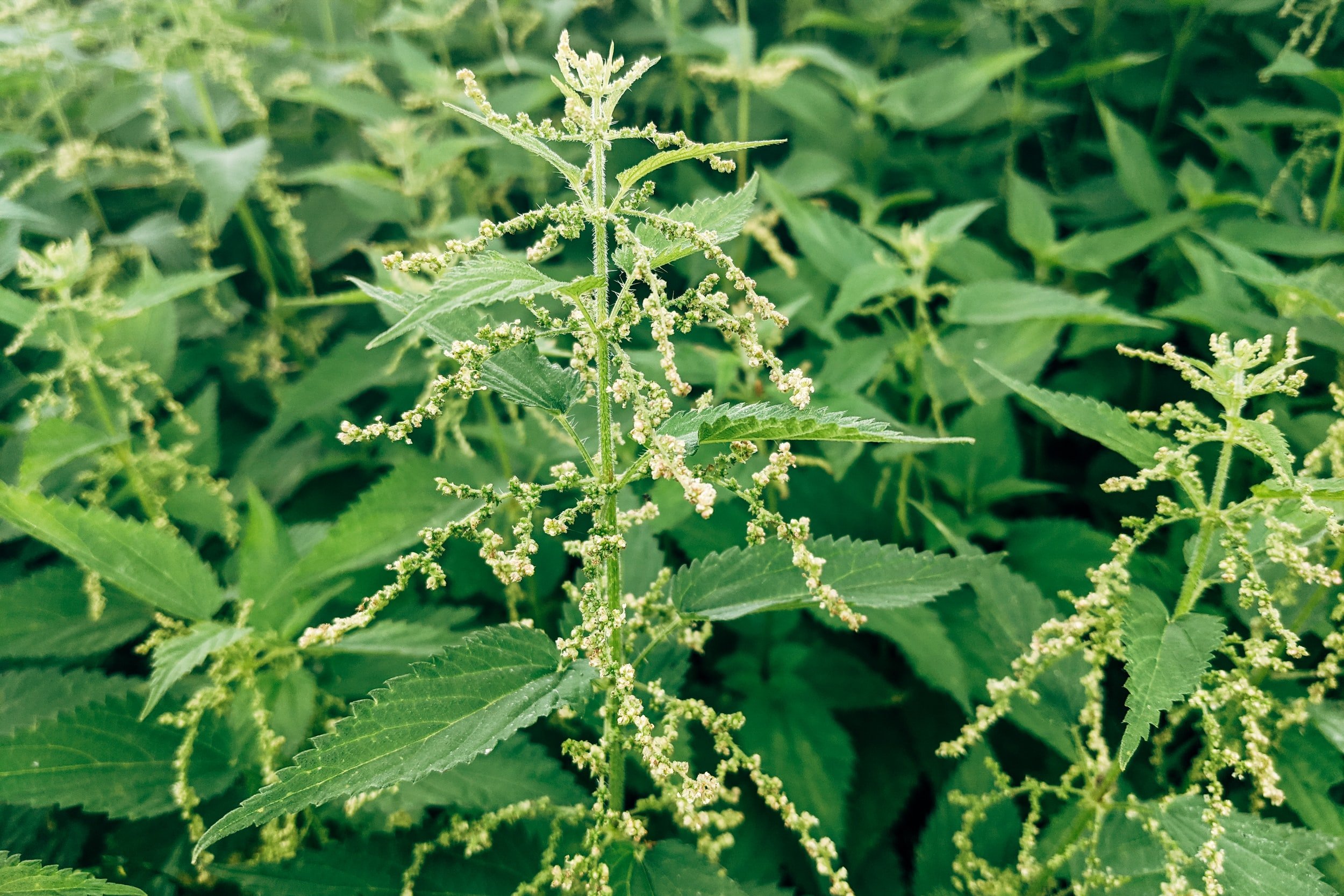The Wild Wisdom of Stinging Nettle
Stinging Nettle, also called Common Nettle, is a plant that many people try to avoid due to the fact that it is covered in fine hairs that, when touched, produce a stinging or burning rash that can last anywhere from an hour to a few days. The rash is luckily localized to the sting location and does not spread and can be minimalized with mud, baking soda, jewelweed, or plantain. Stinging Nettle, however, is not something that should be avoided. It has amazing healing properties and should instead be celebrated.
Stinging Nettle is a powerhouse of nutrition and is perfectly safe to consume when dehydrated or cooked. Stinging Nettle tea is an amazing Spring Tonic to help the body rejuvenate after the long dark days and heavy foods of winter. Be sure to wear gloves and long sleeves while gathering and handling Stinging Nettle until it is cooked or dried. Also remember to not harvest stinging nettle for food consumption after it has flowered due to a high level of alkaloids.
Stinging Nettle’s benefits do not end at providing both food and medicine. Stinging Nettle also creates a beautiful dark green fabric and yarn dye, especially when combined with an iron mordant on wool. In ancient times, the Stinging Nettles tough, stringy stalks were even made into fiber and rope.
Several plants may be confused for Stinging Nettle and this list includes Mexican Hedge Nettle, Wood Nettle, Dead Nettle, and False Nettle. Stinging Nettle acts as a colonizer plant and grows well in disturbed ground that is damp and fertile. It grows in woodlands, fields, hedgerows, and gardens. It is often found in riparian habitat along stream and lake beds. It is native to Europe, temperate Asia, and northwest Africa. It is naturalized in the United States and most of Canada.
Stinging Nettle is often identified by the stinging hairs which are obvious when observed close-up. The leaves are coarsely toothed and pointed. It often grows in dense clusters and can grow 5-8 feet tall. There are both male and female stinging nettle flowers. Female flowers are typically small and white and droop down in long clusters. Male flowers are white to green to purple and are typically more upright.
Nettle can be used as a substitute for spinach in recipes. It is often consumed as a tea. Stinging Nettles are extremely high in Calcium and are high in Vitamin C and fiber. They also contain notable levels of Iron, Vitamins A and K, Zinc, Selenium, and Magnesium.
Stinging Nettle Salve*
A salve is a topical product consisting of herb infused oil, beeswax, and optional essential oils. Stinging Nettle salve is anti-inflammatory and is used to help with arthritis, joint, muscle, and nerve pain. Stinging Nettle can help calm eczema. It also works as a topical antihistamine when applied to insect bites.
There is no typical salve dosage. Apply a salve as needed but remember that a little salve goes a long way. Applying the salve one to four times daily to affected areas is appropriate. Salves have a shelf-life of about one year stored in a cool location. They tend to melt into a liquid at high room temperatures which is why storing in a cool location is necessary.
Stinging Nettle Tincture*
A tincture is a concentrated herbal extract made by infusing alcohol with herbs. Stinging Nettle tincture is known for helping with a wide range of health problems including anemia, exhaustion, allergies, menstrual problems, prostrate health, and rheumatism.
A typical dosage of Stinging Nettle tincture is 1/2 to 1 ml three times a day or as directed by your health care provider. Alcohol based herbal tinctures have a shelf life of about three years.
Stinging Nettle Flower Essence*
Flower essences capture the healing vibration of a plant. They work on a different level than tinctures or salves. Flower essences work on helping with emotions, traumas, and fears. They do not work on physical problems or disease although they can help with the underlying emotions behind a disease.
The Stinging Nettle Flower Essence is here to assist when life “stings.” This nettle flower essence is about helping us through the pain so that we may let go of what is holding us back. This flower essence will help us see through the fog so that we may make our best life choices and move on from past regrets.
Stinging Nettle Around the Web
Interested in learning more about Stinging Nettle? Check out these Stinging Nettle links from other bloggers.
Nettle Pesto by Hunter Angler Gardener Cook
Dyeing with Nettles by Rebecca Desnos
How to Gather and Process Nettles for Cordage Making Fibers by Jon’s Bush Craft
Stinging Nettle Cake by Nordic Forest Foods (NOT gluten-free)
How to Harvest Nettle Without Getting Stung by Mountain Rose Herbs
Are you interested in learning about the wild wisdom that each plant has to offer? Check out Wild Wisdom Botanicals Wild Wisdom Collections. Each herbal collection features a dried medicinal herb as well as a flower essence, tincture, and herbal salve. All plants used to make Wild Wisdom Botanicals are lovingly grown or sustainably foraged on our wild, happy and nourished homestead.
*These statements have not been evaluated by the Food and Drug Administration. This product is not intended to diagnose, treat, cure, or prevent any disease.
This content is provided by informational and/or educational purposes only. This content is not meant to be a substitute for professional medical or health advice, and you should not accept it as such. If you need medical advice, evaluation, consulting, then you must seek help by a qualified physician or health care provider in your area. Do not ignore or delay your physician’s advice based on something you read on our site. Although every effort is made to ensure that this information is correct, use this information at your own risk.




